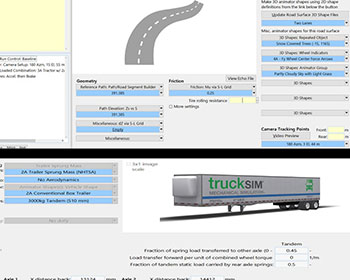Research Reports
Report Details
Abstract
 Speed limits play a pivotal role in traffic safety on mountainous roadways. Due to Wyoming's unique conditions, designing mountainous roadways with appropriate design speeds is challenging. These roadways are characterized by adverse weather conditions and tight horizontal curves with steep downgrades or vertical curves (combined horizontal and vertical curves). Skidding and rollover toward the outer direction of the curve are the main threats on these curves. The current speed limit design policy in the Green Book (AASHTO 2011) obtained from the design of the horizontal curve does not account for these challenges and has shortcomings. This research aims at evaluating the appropriateness of the posted speed limits and vehicle stability on Wyoming's hazardous curves. This research also intends to propose a new design framework to set speed limits on combined curves with respect to vehicle stability. Therefore, a high-fidelity dynamic simulation modeling approach was used to assess lateral and roll stability of different vehicle types on various road surface conditions. The results showed that the current speed limits are unsafe and should be modified under some circumstances. Vehicle stability significantly changes based upon the vehicle type and configuration coupled with weather conditions, and therefore appropriate speed limits vary accordingly. The developed models of SMs and RMs quantify accurately the impact of the geometric and environmental characteristics on the vehicle performance when cornering. The proposed framework and assessment will assist Wyoming's roadway authorities in imposing more appropriate speed limits for vehicles on hazardous sections based on the weather conditions and vehicle configurations. Furthermore, the results would be beneficial for companies developing automated trucks.
Speed limits play a pivotal role in traffic safety on mountainous roadways. Due to Wyoming's unique conditions, designing mountainous roadways with appropriate design speeds is challenging. These roadways are characterized by adverse weather conditions and tight horizontal curves with steep downgrades or vertical curves (combined horizontal and vertical curves). Skidding and rollover toward the outer direction of the curve are the main threats on these curves. The current speed limit design policy in the Green Book (AASHTO 2011) obtained from the design of the horizontal curve does not account for these challenges and has shortcomings. This research aims at evaluating the appropriateness of the posted speed limits and vehicle stability on Wyoming's hazardous curves. This research also intends to propose a new design framework to set speed limits on combined curves with respect to vehicle stability. Therefore, a high-fidelity dynamic simulation modeling approach was used to assess lateral and roll stability of different vehicle types on various road surface conditions. The results showed that the current speed limits are unsafe and should be modified under some circumstances. Vehicle stability significantly changes based upon the vehicle type and configuration coupled with weather conditions, and therefore appropriate speed limits vary accordingly. The developed models of SMs and RMs quantify accurately the impact of the geometric and environmental characteristics on the vehicle performance when cornering. The proposed framework and assessment will assist Wyoming's roadway authorities in imposing more appropriate speed limits for vehicles on hazardous sections based on the weather conditions and vehicle configurations. Furthermore, the results would be beneficial for companies developing automated trucks.
How to Cite
Alrejjal, Anas, and Khaled Ksaibati. Proposing New Advisory Speeds in Mountainous Areas Considering the Effect of Longitudinal Grades, Vehicle Characteristics, and the Weather Condition, MPC-22-457. North Dakota State University - Upper Great Plains Transportation Institute, Fargo: Mountain-Plains Consortium, 2022.